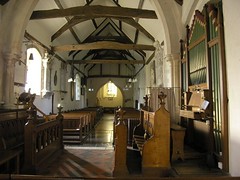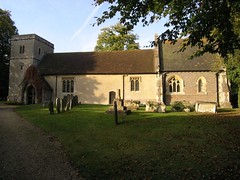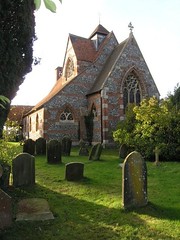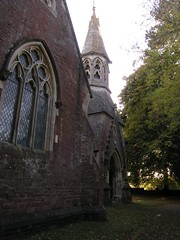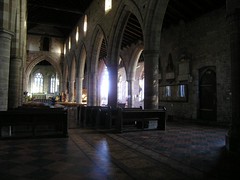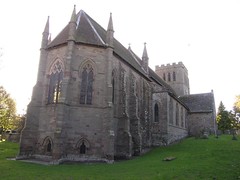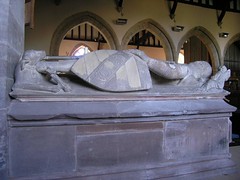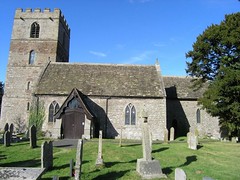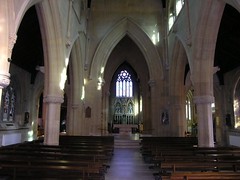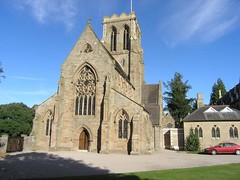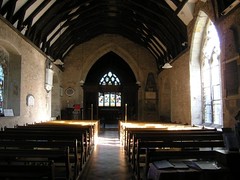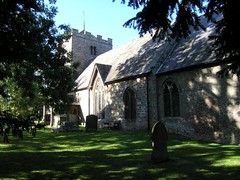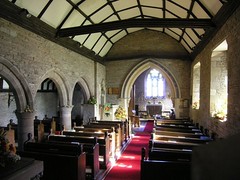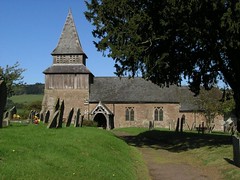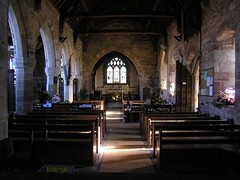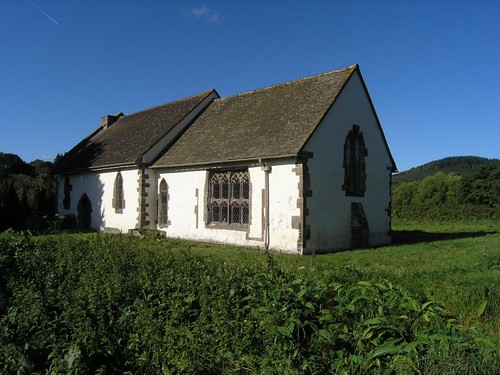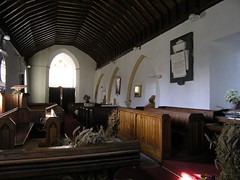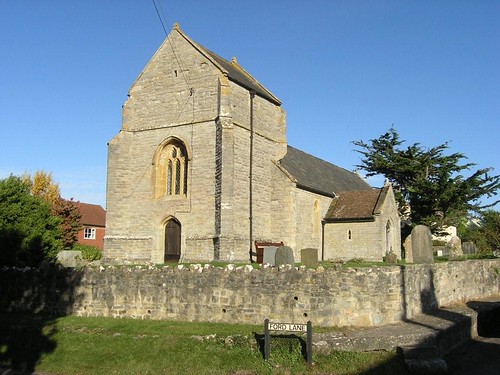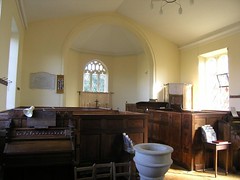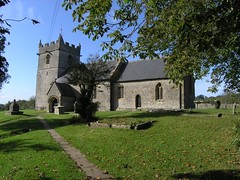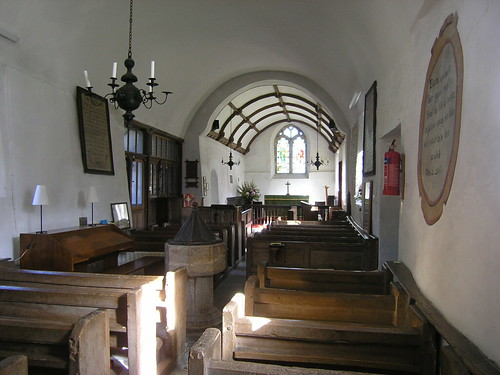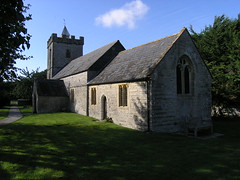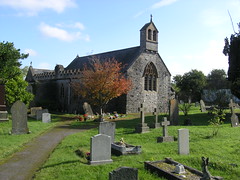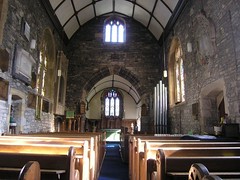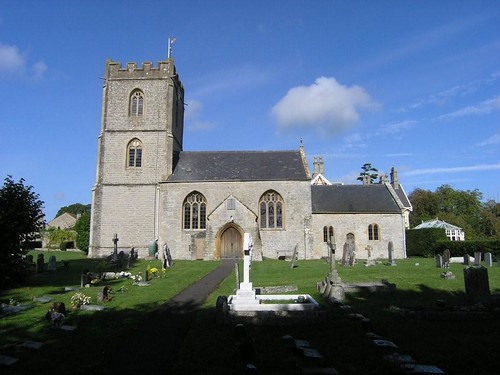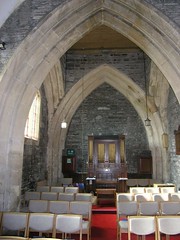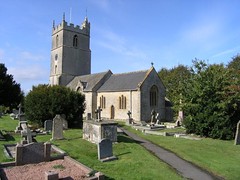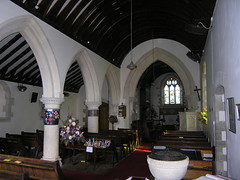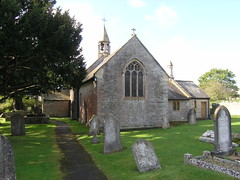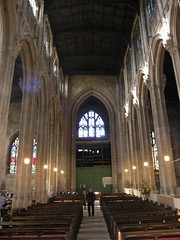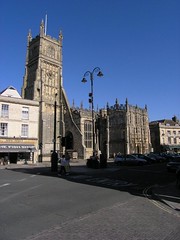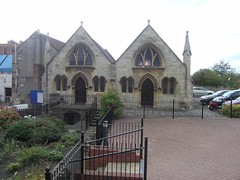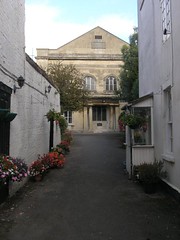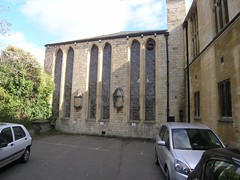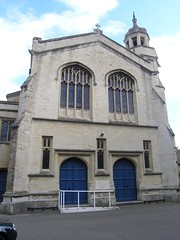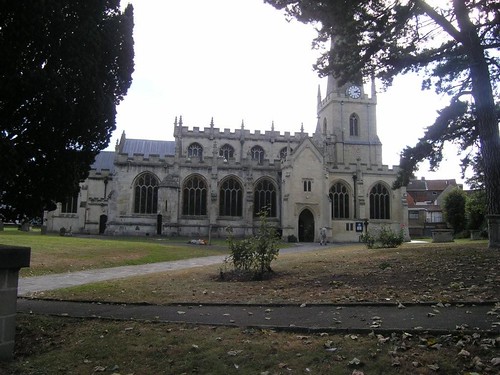On a closer look, both supporters on the Royal Arms are male and rather pleased to see each other...... so the unicorn must be in drag!
I am a little embarassed to have added this picture in its full glory now!
Saturday, October 17, 2009
St Andrew, Chaddleworth, Berkshire
The interior is absolutely charming with much to see, helped by an ancient roof, many many memorials and a feel of being somewhat different to the norm. Apart from the chancel (which fits in much better inside) there is a feeling of gentle conservation rather than restoration. Georgian pulpit with inlay, two fonts (one a fluted column supporting a bowl, the other plain recut Norman with four attached shafts supporting the bowl). The chapels are raised up a few steps higher than the nave floor, one is open into the church and panelled, the other with a glazed screen - locked. Two other features caught my eye, firstly the tower arch which Pevsner doesn't pass comment on which has an ogee arch. In my years of churchcrawling whereas I have seen several doorways and tomb recesses with this type of arch, there are few other examples that spring to my mind of one so large as here. The other feature is really two, and that is the sets of Royal Arms which are near-identical, one undated and the other more damaged dated 1722. Why did they catch my eye? A really goofy lion (missing on the second set) and a Disney-cartoon lady unicorn who you can just see batting her eyelashes could she come to life!
St Andrew, Chaddleworth, Berkshire
On my way back home and towards the Wantage - Hungerford Road from Leckhampstead I had to pass through Chaddleworth. The church is right on the edge of the modern village. It is long and low with a broad rectangular-in-plan west tower, nave and chancel in one with south porch and two family chapels (1706 and 1765) on the north side. To this G E Street added a new "stuff-you" Victorian chancel, higher, different stone and therefore making no attempt to blend with whats there and 150 years has not made it mellow any further! The porch shelters a good Norman doorway and the tower west window also has some Norman work to the head of the window outside.
Friday, October 16, 2009
St James, Leckhampstead, Berkshire
I found the church open. The nave is four bays long with an arcade of three bays and in its eastern bay a higher transeptal like arch under which is placed the organ. This east bay sweps up inside the nave to form this crossing-like space whereas the aisle ignores it. The end walls of the aisle and the dormer-like extensions have triangular windows or rather the traceried heads of windows without the lights below. The west end of the nave is curtained off, unfortunate in appearance but presumably a necessity as there is no vestry. Within all of this Victorian rogueishness, it is a surprise to record that the pulpit is Jacobean, the communion rails in part C18 and the font an interesting cup shaped Norman design with bands of leaves at the top and bottom; the base with further decoration looks to be C19 restoration.
St James, Leckhampstead, Berkshire
I took a slight detour on my way home on Tuesday to see this church by S.S.Teulon. It is not very large, but is an astonishing building, all of red yellow and black brick with much patterning inside and out. It has the tiniest of west bellcotes and a small timber bell turret as well, but the latter is placed above the "crossing", a meeting of odd gabled transept like dormers in the east bay of the nave which give the efect of a central tower in grouping. The roof extends down to cover the south aisle and there is the shortest of chancels, slightly narrower and lower. Timber south west porch which can't offer much protection on a stormy day.
Wednesday, October 14, 2009
Christ Church, Llanwarne, Herefordshire
Some time ago I posted pictures of the ruined church of St John at Llanwarne, only to get home and discover that almost opposite (SW) of the ruins is the replacement Victorian church above the road. Although Madley was my last intended church, I passed the turning for Llanwarne on the way home and detoured to find Christ Church and indeed it was open. It is sizeable, cruciform with an E apse and dates from 1864. The steeple over the north porch is quite fun, and inside the two nave south windows have many C17 Netherlands glass roundels. Some minor memorials were transferred to the new church along with a C17 chest and C17 font with acanthus leaves decoration probably from St John's, as there is also a second C19 font.
Nativity of the Virgin, Madley, Herefordshire
The interior is impressive and there is a play of light from the large windows of the outer south aisle and choir with the gloomier nave. On the east wall of the bave are substantial remains of wall paintings. The font under the tower, circular and comparitively plain is one of the largest in England. At the east end of the north aisle is a family pew complete with screens, curtains, hatpegs and internal benches. Pevsner erroneously calls this a parclose screen; it is completely free standing. Disappointingly few monuments in the church - a typical "kneelers" hanging monument in the chancel some wall tablets of varying quality and an Elizabethan tomb chest at the west end of the outer aisle with broken effigies but an amusing flamboyant son and daughter in one side panel. Stalls in the chancel with misericords, all fairly simple and of the same design, and a mosaic of medieval glass fragments in the apse windows.
Nativity of the Virgin, Madley, Herefordshire
This church was the reason for the trip, yet as you have seen, I get detoured by others, and I never arrived here until nearly 4pm. The sun was getting low and made photography difficult inside and out. This is the view you get approaching the village from Hereford, one of England's rare medieval apses, emphasised by pinnacles, and built over what is said to be England's last medieval crypt. This is a large church, the tower at the west end is not dominant yet still stately, and it is embraced by the aisles. The west end is all C13 with lancet windows, and the clerestory is a row of lancets. There is an outer south aisle too, Decorated, and the north aisle east of the large porch was widened with new windows at the same time.
All Saints, Clehonger, Herefordshire
Finally those monuments and there is the usually collection of C17-C20 wall memorials, none particularly worthy of note here. A tomb recess in the aisle, probably late C13, contains a foliated cross coffin lid. Another half of a coffin lid with much better C13 carving survives by the organ in the SW corner of the church. Sir Richard Pembrugge founded the N transept chantry in 1341 and he lies under the arch on a recent base.The effigy is quality work, his head on a pillow supported by angels (one upper half missing) and the dog at his feet playfully chews the end of his sword. In the NW corner is a much smaller effigy of a lady - presumed to be his wife Petronella - two angels again by her pillow and with a large bird at her feet pecking at her cloak. On the west wall brasses to Sir John Barre d1483 and his wife, she turned towards him showing a shapely figure.
All Saints, Clehonger, Herefordshire
The interior is fairly standard stuff in Herefordshire, but what makes it outstanding are the monuments. However before I venture there let me point out the roofs which incorporate much C17 woodwork but not mentioned by Pevsner. Again for such a large tower there is not much of a tower arch inside and there is a blocked opening above this. Four-bayed arcade.
All Saints, Clehonger, Herefordshire
The church is situated a good half a mile from the village, luckily for me on the Belmont side of the village although I had to brake suddenly when the sign loomed into view. This turned out to be the only locked church of my day out, but be assured it is well worth getting the key here (map under the lychgate). the four staged west tower has no doorway but does have openings on all sides. I liked the way the lancets get progressively bigger on each stage! Nave with south aisle and porch and north transept, and chancel. Once unlocked the porch doors reveal a good Norman doorway with waterleaf capitals and a medieval door.
Belmont Abbey, Herefordshire
The entrance has shifted from the north porch to a brand new glazed vestibule with automatic doors in the south east corner meaning you enter the church by the south transept. Work was proceeding on the organ whilst I was here, and for that reason I believe I had unrestricted access to the whole church. I noted alarm sensors at the entrance to both choir aisles and ropes hung across the crossing arches warning of no access. So be prepared if you come here to only visit the nave and transepts. Two tombs to two bishops in the north transept. The church has recently been restored following a Heritage Lottery Grant.
Tuesday, October 13, 2009
Belmont Abbey, Herefordshire
The abbey church of St Michael is part of a modern-day catholic foundation. I came here first in 1972 and this was my only visit since. How the area has changed, even the entrance to the grounds from the Abergavenny road just outside of Hereford is blocked off and the whole site - once a school - is now occupied by housing. The church lingers on by the side of a minor road at the back of all this development and is still served by Benedictine monks. The abbey buildings survive too to the south of the church. The church is by E W Pugin 1854-60, the tower completed by Pugin & Pugin in 1882, and it served as a cathedral for Wales 1855-1920.
I was still at school in 1972 and made a bad mistake of walking out from Hereford to see the abbey. It took so long I was so worried about getting back for my train home that I had to rush round the church . However sensing my "distress" a friendly monk chatted to me in the church, invited me to the refectory for a cup of tea and cake before taking me in his old car to the station well in time for my train home. Acts of unexpected kindness like this have remained with me over the years.
I was still at school in 1972 and made a bad mistake of walking out from Hereford to see the abbey. It took so long I was so worried about getting back for my train home that I had to rush round the church . However sensing my "distress" a friendly monk chatted to me in the church, invited me to the refectory for a cup of tea and cake before taking me in his old car to the station well in time for my train home. Acts of unexpected kindness like this have remained with me over the years.
St Andrew, Allensmore, Herefordshire
The interior has several interesting wall memorials and am incided slab made in the design for brasses of the period. Here the inlay is cement rather than brass. There is also a Victorian font, finely detailed with an unusal design, and a Jacobean pulpit of handsome appearance, again not quite the usual type. The tower however has no impact inside, with an arch more like an overgrown doorway. However there's that window again - it floods the church with light.
St Andrew, Allensmore, Herefordshire
Another bulky west tower, and a wooden south porch which shelters a Norman doorway. Pretty churchyard = lots of trees = difficult external photos! The feature that will stay with any visitor however is the huge south window of the nave, C14.
St Mary, Orcop, Herefordshire
The interior was still festooned for the Harvest Festival held the day before. The tower has a complicated timber structure inside but otherwise the interior is simple and pleasing. Narrow C13 north aisle with some memorials on the back of the arcade. High victorian font and pulpit, and also the remains of a Norman pillar piscina in the chancel.
St Mary, Orcop, Herefordshire
On a hillside, my first glimpse being of it at the back of a field of maize (I think). Typical local timber tower on a stone base and a timber south porch. The only real surprise outside is the chapter-house-like vestry at the north-east corner. Many of the details seen date from the Victorian restoration. However it is quite charming in my humble opinion
St Weonard, St Weonards, Herefordshire
Inside the church is spacious, and again the size of the tower is dominant. The C15 chancel screen has recently been removed to the first bay of the north aisle, and the benches removed from here to create a space for other use. The matching north aisle screen remains in situ but both to mee seemed to be more restoration than original woodwork, Odd fancy niche in this aisle with a stylised angel bracket above. The large four light east window of this aisle is filled with C15 stained glass, albeit restored. Also in the aisle the best memorial, d1765, a handsome composition with (top to bottom) hand grasping gauntlet, crest, small black draped urn, two cherub heads, inscription and garland. Another less successful monument is hidden away behind the organ, d1675, with stepped shafts top by stone balls
St Weonard, St Weonards, Herefordshire
St Weonard's is a large church on a hilltop, and set back from the main road from Monmouth to Hereford with a farmyard in front. This was very handy as I wanted to get some free range eggs today, and I didn't have to make a special stop for these. The tower is massive, and the church has nave and north aisle of almost equal width. The south wall of the nave shows some late C13 features but otherwise it is all Perp. Nice views from the churchyard.
Monday, October 12, 2009
St John the Baptist, Llanrothal, Herefordshire
There is not a huge amount to see inside at first glance but actually the church contains a C17 cross and candlesticks (Italian, silvered wood) on the altar, a pulpit with Jacobean panels and some minor remains of tomb slabs. However there is a C15 candleabrum complete with a figure of the Virgin. Apart from the pulpit all of this was donated by the first chairman of the CCT or Redundant Churches Fund as it was then. Finally for me an architectural puzzle - why the huge Perp window on the south side of the chancel, its head mutilated and quite out of character here. It is quality work - so did it come from elsewhere?
St John the Baptist, Llanrothal, Herefordshire
One of the most isolated churches in Herefordshire, reached by road from Welsh Newton along a 3 mile or so no through road. There is a bend in the road when you first see the church across the fields, and there is a grassed track leading to the church from the road a little further on past the church itself. This is now a Churches Conservation Trust church, and here they have done something unusual, as they have re-roofed the nave. They have also made a chancel arch of sorts, as the chancel had a west wall before vesting. It is probably never locked. Nave and chancel only, with the base of a former west bellcote. The dedication was formerly St Rhyddol, but was changed c1200. This part of England was still welsh-speaking in the early C19.
St Mary, Welsh Newton, Herefordshire
The odd external dormer window is explained inside, inserted to light the rood screen. And this is a rare screen, a three bayed arcade in effect running across the church, the central arch narrower than the others. The east window behind is the only minor jarring feature, plate tracery of the Victorian period., and a match for the pulpit of the same time. Not much else to note, the font is probably C13 but a featureless tub-shaped example.
St Mary, Welsh Newton, Herefordshire
Nine more churches visited today - well the weather was absolutely stunning, although the sunshine caused problems with the photography later in the day. No such problem here at Welsh Newton though, where the rather quirky church basked in the sunshine. Very slim west tower and broach spire, more like an oversized turret. Nave and chancel in one rectangle, lots of lancets plus an odd stretch of corbel table on the south side of the chancel. Another odd feature is the dormer window, entirely C14. The bush on the right is close to the grave of a saint, St John Kemble, a catholic priest, hung drawn and quartered in 1679 in Hereford. Canonised in 1970, there was little evidence of pilgrimage today, apart from a rosary and tea-light candle on the grave.
Sunday, October 11, 2009
Woolavington Postscript
Originally uploaded by ChurchCrawler
This is the second picture I took, this one without the car which pulled up and parked outside directly in my intended shot for the first one. The lady and her daughter had turned up with some boxes to place in store with some of her furniture and had the keys to the church and the schoolroom next door. Or so they thought. She had to drive off again to fetch them but was happy to let me see inside both buildings. No features survive inside apart from one pew, which may not come from here, and one wall memorial.
Still - what are the chances of that eh? Spooky. So all churches tried, all churches accessed. A very good ChurchCrawl.
St Francis, Stawell, Somerset
It is clear that either Pevsner or his student never came here, or it was the last church of the day. There is no mention of the C15 font (usual style!) but also no mention of the blocked C14 three-bayed arcade in the north wall of the nave. There is no excuse (e.g. saying the church was locked) as there is evidence outside of this too. So the line in BofE "The nave is aisleless" is strictly true but there is more to it! As for Stawell church , now I have mentioned that, there is not much else to it.
St Francis, Stawell, Somerset
Another former chapelry of Moorlinch, but now carries the dedication of St Francis which in the CofE is usually a C20 dedication in my experience unless others know differently. It is largely C13 with several lancets, and the base of an intended west tower finished off by a saddleback roof.
Chapelry, Sutton Mallet, Somerset
The interior is small and simple, with original Georgian fittings including a three-decler pulpit. Keen eyes - probably Dutch - will spot TWO harmoniums, not sure why this church needs two unless they have competitions with them similar to "Duelling pianists". Hat pegs on the side walls and also a west gallery.
When I came out to the car I discovered a bus waiting blocking the road, or so I thought. Actually it was me blocking the bus because of where I had parked as it could not turn the sharp corner. I drove away sharpish!
When I came out to the car I discovered a bus waiting blocking the road, or so I thought. Actually it was me blocking the bus because of where I had parked as it could not turn the sharp corner. I drove away sharpish!
Chapelry, Sutton Mallet, Somerset
An oddity, and difficult to photograph from any other angle but this one. It is vested in the Churches Conservation Trust and a key is available from a nearby farm, although the farmer has tried to leave it open but the village has been plagued by yoof who took to "playing" in here as some entries in the VB still evidence. The church is the work of Richard Carver, 1829, but the tower is medieval altered and heightened.
St Mary, Moorlinch, Somerset
It was one of those doors which open with a normally satisfying heavy clunk of the latch lifting, so thankfully there was no service just a friendly organist practising for today's service. Inside much C15 woodwork - bench ends, pulpit, lectern and also a later west gallery. there is also a Norman font with a broad nband of cable moulding, not mentioned in Pevsner. In the chancel and resting on two ugly concrete (?) square supports is the otherwise ornate effigy of Lady Elenor de Beauchamp c1375 who wears a squared head-dress.
Note - Pevsner and the church spell the village Moorlynch, whereas the local road signs and officialdom (English Heritage) use Moorlinch.
Note - Pevsner and the church spell the village Moorlynch, whereas the local road signs and officialdom (English Heritage) use Moorlinch.
St Mary, Moorlinch, Somerset
Another church trying to hide, but does not do it as well as Cossington as it is on a hill. Quite a long walk to the porch from the road. West tower, nave, porch and chancel. The tower is unbuttressed and C13 below, the chancel is largely C14 and the rest a medley of styles all tidied up in the C19. Yet the outer doorway of the porch seems to be late Norman, probably reused here. The porch itself shelters a C14 door with blank tracery. From the outside came strains of an organ playing and I hoped it was not a service.
St Peter, Catcott, Somerset
The interior is a delight, seemingly unrestored, long and low with a plastered ceiling to the nave, a strange almost featureless chancel arch and a fine C15 panelled wagon roof to the chancel having carved wall plates with fleurons, ribs and bosses (although most of these restored). The clue was the small windows at the west end of the nave for a west gallery, although the present one seems to be more of a reinstatement of what was once here rather than original C17 work which the listing information says (and Pevsner offers early C19). It is accessed by a pull down ladder on small wheels, and you can closely inspect the Royal Arms dated 1792. Much of the woodwork is C17, there is extra seating available by pulling out sliding benches. Painted texts on the wall too, including one "The aged women...... shall teach the young women to be sober, to be chaste, keepers at home, to love their husbands." The north transept is subdivided and has a glazed screen to the two sections beyond (locked). The only jarring features, clearly seen in my view, the electronic sixties/seventies-styled organ behind the C13 font and the prominently displayed fire extinguisher! The village stocks are preserved in the porch, presumably for among others those young women who did not heed the advice inside!
St Peter, Catcott, Somerset
In all honesty I couldn't tell from the outside that this was going to be my favourite church of the day. Quirky unbuttressed west tower, nave and chancel, amnd looking quite restored from this view (which I rather like as a photograph with its play of light and shadow). If I had walked a little further past the porch I might have seen a clue to what lay inside but in my hurry to try to open another medieval studded door, I missed it! It was open.
St Edward, Chilton Polden, Somerset
Attractive exterior, no tower but a double bellcote. The church was entirely rebuilt 1888-89 by Henry Edwards of Bristol. Some older memorials were replaced into the rebuilt church, but one of the best - an inscised slate is almost hidden with other similar memorials behind the organ, and best viewed from the vestry behind. The font is plain but medieval. Edwards is not very good here (his exteriors are always better than his interiors in my opinion), his arches are all plain continuous single chamfer and this makes his church seem exceedingly plain inside. The chancel arch however is original C15 work, of two continous hollowed chamfers. Medieval too the south door which may originally have fitted a Norman doorway as it is round headed but so as to not build a round arch or reuse what was there before Edwards has hung the door over the current doorway by making it open outwards - and odd this looks too!
St Mary, Cossington, Somerset
The walls of the nave and tower but not the chancel are scraped. There is some good Victorian stained glass in the nave north windows, and the tracery of the east window has four small figures who could be medieval (I am no expert and Pevsner does not mention them). Cusped and empty tomb recess in the chancel. The chief interest would be the C16 brasses on the chancel floor, now hidden under the plush blue fitted carpet. There are however replicas on display in the nave, and close by is an unusually slender C15 font, not mentioned by Pevsner - a surprise seeing how often he mentions medieval fonts as "of a usual type" (as he does at Woolavington!)
St Mary, Cossington, Somerset
Cossington is set in a dip and approaching from Woolavington I couldn't see any church. After a few false roads I noticed Church Farmhouse so parked opposite, and was in fact outside of a C19 Gothic stone arched gateway which opened onto a path leading up to the church. It seems to sit on the lawn of a large Victorian house, and although only consists of west tower, nave porch and chancel is rather a large building, largely Perp - and locked. Back to the foot of the path to study the notice board. Much goings on, services details, rotas, concerts but no keyholder information and no contact information for anyone at all. I asked the neighbours who were working in their garage but they did not know where to suggest so I called at Church Farmhouse, where a helpful gentleman directed me up the hill to a keyholder. Despite the fortress feel I had developed for this church, her welcome could not have been bettered and she was happy to just hand me the key to the church for my visit. Back down the hill and back up the path and then I was inside.
Blessed Virgin Mary, Woolavington, Somerset
This picture shows the west end of the church, the tower space. Ignoring the new carpet and chairs (installed earlier this year in place of Victorian pine benches), the tower has four C13 arches, and these have been blocked. There must have been plans for or former nave and transepts, making this a central tower. For what ever reason plans failed and the present church of nave and chancel constructed. Well - that too is problematic as the chancel has lancets (most now Victorian) and hidden now by the new toilet extension the nave has remains of a Norman north doorway above the Gothic one. (The new extension here replaced an external boiler house, and saw the doorway here unblocked again for the first time in hundreds of years). So was this a planned grander rebuilding of the earlier church which was never realised? Of the rest, the interior is scraped, there are a few minor memorials and a Perp font. Pevsner misses the Elizabethan panelling in the pulpit and the panelled south door with original ironwork and he does not mention the final mystery found on the sill of a chancel window. Here is the head of a man, possibly a priest, too large for a corbel and more likely the head of a lost effigy. It was dug up in a field, when houses were being built in what is now Priory Close. Local lore says this was the site of a former priory which this head would seem to add credence to, but historical records show no such foundation existed here in Woolavington. More likely I guess is that it came from this church or churchyard. The fact it was buried has preserved its remarkable detail.
Blessed Virgin Mary, Woolavington, Somerset
From the outside all seems normal here, a west tower, nave and chancel, all predominantly Perpendicular in style with some Victorian restoration. Not one of Somerset's grand towers, but quite tall and with a higher embattled turret in the north-east corner with its own recessed spirelet. However the fact that the Perp south window of the nave punctures the roof and has its own gable suggests that the nave is older than this. The impressively long list of keyholders in the noticeboard by the church path was not needed as a gentleman was readying the church for today's service. So what is wrong here?
All Saints, East Huntspill, Somerset
The interior of the church has considerable charm, and a surprise is the survival of the original box-pews complete with Norman style decoration. On the south side these slope away considerably due to settlement in the church floor and foundations shortly after it was built. At least here the date of the building of the church is solved as there is a plaque recording the laying of the foundation stone in 1839 which has a second date 1840 which is presumably when it was completed. The Norman decoration is more restrained, and confined to the chancel arch and east window. However the same cannot be said for the exuberant Font covered in all manner of ornament!
All Saints, East Huntspill, Somerset
I don't think anyone can say that the exterior of this church by G P Manners is especially attractive. Neo Norman and dating from 1839 (Pevsner), the west front has a bellcote and decoration recalling the east wall at Tickencote. The church was locked but a quick phone call saw a lady keyholder pop down to open up. I wish I had asked her about the tower. The Listed buildings information says this is late C19, however the church website (on a blog!) says the church was built in 1846 and the tower was added to the porch in 1966. Pevsner writing in the 1950s does not mention the tower.
Chapel Allerton, Somerset
The interior of the church seems entirely Victorian. with a stone pulpit and new font which is odd as the old font also remains at the west end of the nave, probably C13 and with an ornate Jacobean cover. No memorials apart from a few brass inscription plates which is quite unusual too.
Chapel Allerton, Somerset
Yesterday saw a cloudless start to the day, and after a late breakfast I set off to the Somerset levels. My first church of the day was one I had never visited before, despite the fact I had been to all of its neighbours, and probably due to the complex network of small roads between here and the A38. My Sat Nav directed me faultlessly, but the road was blocked by an ambulance attending to an incident in someone's home. I managed to turn round and take a different lane and was soon here.
The dedication of the church has been lost over time and much of the detail belongs to a heavy Victorian restoration and enlargement. Bellcote with two bells over the chancel arch.
The dedication of the church has been lost over time and much of the detail belongs to a heavy Victorian restoration and enlargement. Bellcote with two bells over the chancel arch.
Friday, October 09, 2009
St Mary, Tetbury, Glos
THE place in Gloucestershire for quality antiques (at extortionate prices) is Tetbury, complete with its Highgrove Estate shop. I was astonished that my friends had never been inside the main church of the town, with its complete Georgian interior (minus a large three decker pulpit that is). They showed an interest in it as we drove by en route, and after we had walked the length of the High Street looking at nice things we couldn't afford we found ourselves at the church. A sign outside proclaimed the church to be open, not a state it was found very often in in the 1990s. I had not realised that the west tower and spire was completely rebuilt in the late Victorian era (a picture in the exhibition in the south passage shows it completely gone) thinking the tower was medieval. The rest was rebuilt in 1777 and is in a fancy Gothick. Slim pillars support a plaster vault. The north passage (running along the length of the church and accessed by multiple doors) contains several medieval effigies and two Elizabethan ones with crest from a dismantled monument of some size. My friends were astonished at the graceful interior, and more so at the original Georgian locks and doorknobs on many of the doors. The box pews remain, hiding many a naughtiness I suspect during the lengthy sermons!
Cirencester Parish Church, Gloucestershire (2)
Inside many of the more intrusive partitions have gone, but now the new floor is being laid in the north aisle. The Father Willis Organ is also being completely rebuilt, and many parts of the rest of the church is cluttered with displaced furnishings. My picture - poor and not in focus (and complete with some alien snow flake) - shows the scaffolding tower in the tower and the pews from both aisles which are stored here whilst the work goes on. The story of the restoration is shown on a series of four pages (so far) on the parish website starting here
www.acinc.org.uk/currentevents.htm
Apparently once the work on the floor and the organ is completed, phase two will begin, which is a complete restoration of the "Town Hall" porch. Close inspection of the exterior reveals the extent of erosion of the details, not evident in distant views. So the porch is likely to disappear from view for a period of time, as did the top of church tower at the start of the restoration programme which is likely to cost £6M.
www.acinc.org.uk/currentevents.htm
Apparently once the work on the floor and the organ is completed, phase two will begin, which is a complete restoration of the "Town Hall" porch. Close inspection of the exterior reveals the extent of erosion of the details, not evident in distant views. So the porch is likely to disappear from view for a period of time, as did the top of church tower at the start of the restoration programme which is likely to cost £6M.
Cirencester Parish Church, Gloucestershire (1)
A couple of my friends wanted to look around antique shops yesterday so I went along too. I was intrigued to see what was happening at St John the Baptist church in Cirencester, which has been undergoing some major restoration works in the last few months, and is a few doors along from the Antiques Centre. This famous C15 wool church appeared as usual from the outside (apart from large boards to the west of the tower about the restoration work). This view shows the largest church porch in England, three-storeyed, wih multiple rooms, built by Cirencester Abbey as meeting rooms to conduct its business, and among its uses after the dissolution was the Town Hall of Cirencester, a name which has since stuck. The entrance, fan-vaulted, is more like the cloister walk at Gloucester cathedral, and interestingly the porch is almost detached from the aisle, something I had not appreciated before. Once inside it was evident that the restoration is still proceeding but work in the nave and south aisle is completed to the point that visitors can now enter here again and services are held in this part of the church once more.
Friday, October 02, 2009
Bethel United, Trowbridge, Wiltshire
or Bethel United Church of Jesus Christ (Apostolic)
The church uses the former Unitarian church Sunday schools, the church itself having been demlished in the 1980s.
Strange twin Gothic facades, and of course locked.
The church uses the former Unitarian church Sunday schools, the church itself having been demlished in the 1980s.
Strange twin Gothic facades, and of course locked.
Emmanuel Baptist Church, Trowbridge, Wiltshire
East of the parish church (St James) stands an C18 Baptist church, although the facade is actually of 1904!
Viewed through a locked gate, one that does not seem to have been opened for ages.
Viewed through a locked gate, one that does not seem to have been opened for ages.
St James Hall, Trowbridge
I don't usually post church halls but this one looks more of a church than some churches!
It appears to be a fitness club today.
It appears to be a fitness club today.
The United Church, Trowbridge
At the rear of the church, spoilt rather by the car parking, is an astonishing room with tall lancets, and much older than the rest, 1842.
It is not a previous church but the schoolroom. The church used to be called The Tabernacle, and most books use this name.
It is not a previous church but the schoolroom. The church used to be called The Tabernacle, and most books use this name.
The United Church, Trowbridge, Wiltshire
The church is shared United Reformed and Methodist. It was built in 1882, and has a charming complex of buildings set around a courtyard and with some ancient cottages (almshouses?) as part of the group. Locked.
St James, Trowbridge, Wiltshire
This is the medieval parish church in the centre of the town, an important building, and with three porches, two tall ones with parvise rooms above to the north and south, and a low west porch; all three were vaulted, all three had fancy metal gates and all three had chains around the gates. No contact information anywhere in any of the porches or on any of the notice boards. How are people supposed to contact this church to arrange a wedding or funeral, when if ever is it opened for visitors? Whereas Holy Trinity felt alive and part of the town, albeit difficult to reach over the two lanes of circling traffic, this church set in the heart of the county town of Wiltshire in the pedestianised area, and one of the most important buildings in the town did not feel like it wanted to be part. Even the town trail sign I passed omitted the church as one of the sights - why?
Trowbridge is not alone here, as the same I found applies to the churches at Bradford on Avon Chippenham, Corsham and Melksham, all fairly nearby. However BoA Chippenham and Corsham publicise some limited opening times in the mornings or weekends and there was a phone number at Melksham, but here at St James in Trowbridge nothing. Shameful.
Trowbridge is not alone here, as the same I found applies to the churches at Bradford on Avon Chippenham, Corsham and Melksham, all fairly nearby. However BoA Chippenham and Corsham publicise some limited opening times in the mornings or weekends and there was a phone number at Melksham, but here at St James in Trowbridge nothing. Shameful.
Subscribe to:
Comments (Atom)

